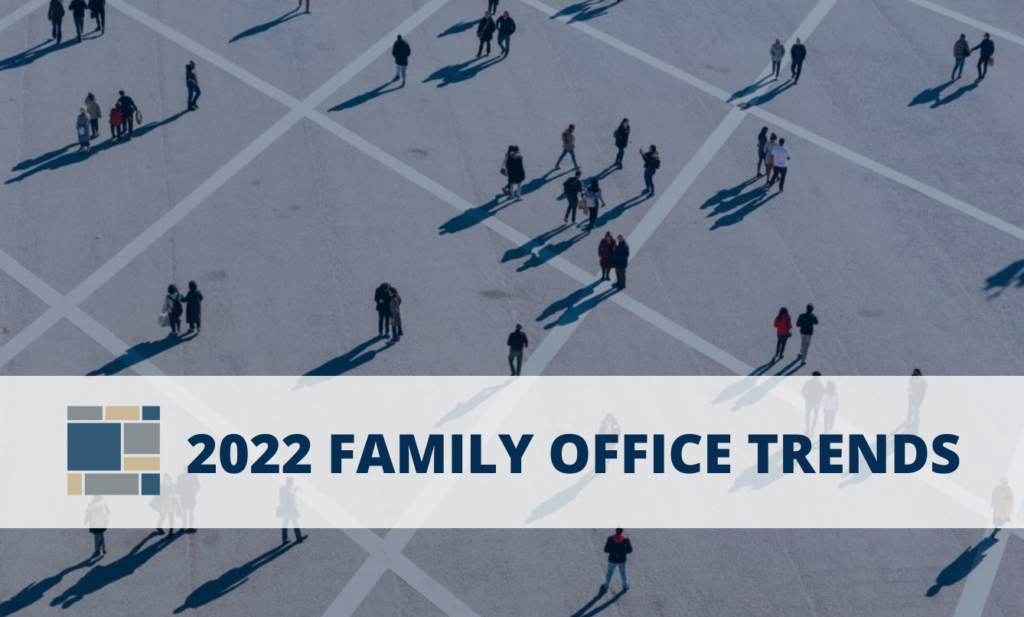Trend 1 – Single Family Office Leadership
There is a demographic shift occurring within the leadership of SFOs. Many are led by an aging family member or a trusted professional that has worked with the family for decades. This transition raises a series of critical decisions. For example, analyzing the family’s current service requirements and their vision for what these may look like in the future. Is the vision to maintain the SFO generationally, and will the costs outweigh the benefits? Clarity on these macro-objectives will help inform the family of a potential new leader’s necessary experience and cultural alignment.
We have seen SFOs that have groomed the next leader and are well prepared for this transition. However, we have also witnessed many struggling with how to best address this complex problem. Experienced leadership candidates are hard to find and expensive. Plus, the transition into a highly functioning team takes time.
Best practices include developing thoughtful long-term budgets inclusive of the cost of new leadership, engaging industry experts in the search, and being creative around what might work best for the family long term.
This process should include “what if” scenarios on outsourcing core service elements, thereby reducing the responsibility and expense of new leadership.
Trend 2 – Tax Efficiency
Concerns about high taxes are top of mind. Questions include what strategies should be considered to create the most tax-efficient results, including analyzing if the SFO has the right fact pattern to create a for-profit management company.
Related to management companies, the 2017 tax changes, potential tax increases, and IRS rulings around SFO structures provide a good backdrop for value-add discussions. If the SFO has the correct fact patterns, this strategy can add measurable value and potentially enable the SFO to create a sustainable economic model into the future.
To learn more about Pathstone and the services we provide to families and family offices, please visit our website at www.pathstone.com.
Trend 3 – Single Family Office Technology & Controls
SFOs have historically utilized third-party software to assist with accounting, investment performance reporting, bill pay, middle office controls, and investment administration. Unfortunately, these software packages typically do not synch with each other. Therefore, the SFO is forced to build internal controls and solutions to create customized deliverables for the family. Integrated solutions now exist and are proven to address this challenge.
Many SFOs get stuck determining which software tool will integrate with their existing platform and how to implement the change without disrupting services. Many SFOs continue to utilize multiple software solutions coupled with excel spreadsheets to provide the family with the information and format they prefer. This manual process is labor-intensive, fraught with data entry errors, and typically does not provide timely information for the family to make decisions. Linked to this software conundrum is the critical element of ensuring that there are adequate controls around money movement and cybersecurity.
SFOs address this issue by examining hardware, data centers, employee approval/review layers, and multi-factor authorizations. Best practices vary depending on how the SFO has addressed the first several trends. For the SFOs that have determined outsourcing is a long-term strategy, there has been significant demand for middle-office services, including accounting, bill pay, controls, secure storage, and consolidated investment reporting.
Trend 4 – Shifting Service Demand
Most SFOs are serving multiple generations. The younger generation is asking for an engagement model that is quite different from the traditional one. They are asking for digital delivery of timely information and instant access to data when needed, yet still would like an intimate, customized service experience.
This shift creates strategic challenges around leadership, scope, talent, solutions, and technology. SFOs that are successfully navigating this trend have acknowledged the interrelated nature of these decisions. For example, having the right leader who can adjust the SFO’s platform and, importantly, the culture to match this new demand is vital. However, not addressing the technology platform challenge will hamstring this leader’s success in serving this major shift in demand.
Trend 5 – Investment Pivot
Active managers, inclusive of alternatives like hedge funds, have been challenged to keep up with relevant benchmarks over the last decade. As a result, SFOs have pivoted and started to allocate larger percentages to private investments, both private equity and real estate.
Also, there has been an increased demand for access to innovative, reasonably priced, and tax-efficient solutions across traditional asset classes. Sophisticated unified managed account structures are filling the need for low-cost/tax-efficient traditional equity allocations allowing the SFO to focus their time on private investments. This focus has resulted in a greater demand for private deal flow and comprehensive reporting on the larger private investments volume.
Trend 6 – Impact Investments
The ESG/Impact space has matured. There are now attractive solutions across asset classes. The idea of sacrificing returns to invest thoughtfully can now be argued with facts and results. Obviously, this trend is connected to Trend 4 Shifting Service Demand. Many SFOs are focused on meeting the demand of the next generation to invest well and do so in a thoughtful and impactful manner.
Recent developments in this space include detailed measurements to review the portfolio’s potential “impact”. New tools and solutions have been created to compare an ESG portfolio to standard benchmarks like the S&P 500. Investors can compare how their portfolios score on ESG elements and adjust their portfolios based on their values.
Our observations include effective SFOs providing optionality and customization at the portfolio level, which will help the family member personalize their portfolio based on their individual preferences and values. Most SFOs we have worked with have determined a method to partner with an outside investment firm/advisor with access and experience in the impact space.
Please see the PDF version of this article, Top 6 Family Office Trends in 2022, for important disclosures.
The original version of this article was published in the Family Office Magazine 2021 Spring Issue.




















